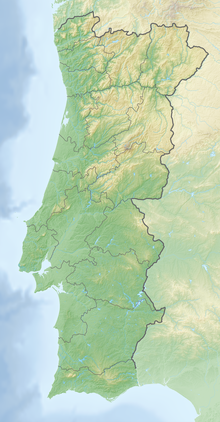Cerro do Castelo de Santa Justa
Coordinates: 37 ° 25 '15.9 " N , 7 ° 42' 10.1" W.
Location of the Cerro do Castelo de Santa Justa in Portugal. |
The Cerro do Castelo de Santa Justa , also known under the name Povoado calcolítico do Cerro do Castelo , belongs to the group of Copper Age , fortified settlements in the south of the Iberian Peninsula , which are associated with the emergence of the bell-cup culture .
location
The settlement is located about 120 m southeast of the town of Santa Justa in the municipality ( Portuguese Freguesia ) Martim Longo , district ( Portuguese concelho ) Alcoutim in the northeast of the Algarve .
The site is on the top of a hill (230 m above sea level), which rises about 50 meters above the surrounding area. In the east it is bounded by the course of the Ribeira da Foupana.
Monument preservation
The settlement was discovered in 1978 by Víctor Manuel dos Santos Gonçalves in the course of a prospecting and archaeologically examined in the years 1979-1984 in annual campaigns .
In 1990 the complex was registered as Imóvel de Interest Público and placed under protection.
Findings
The inner settlement area (approx. 34 × 15 m), protected by an oval wall ring made of greywacke , extends over an area of around 4 acres .
Walls
Five construction phases of the fortification could be distinguished.
The originally simple wall ring with two bastions and an easy access was supplemented in phase 2 by a pincer gate on the eastern narrow side and two further bastions, the access in the north was closed.
In phases 3–5 the walls will be reinforced and additional bastions will be built. In the last phase 5, the complex has five bastions on the northern and four bastions on the southern long side. Some of the bastions are massive, but some are also hollow.
building
Several buildings with a round or oval floor plan were excavated inside and outside the wall. T. were used separately according to functional areas. Buildings with fireplaces can be distinguished from those that were used for weaving.
Finds
Besides Copper Age pottery among others polished were stone axes , arrowheads from flint and loom weights and the " sacred " area attributable "Horn idols recovered" in the course of excavations.
Crucibles , castings and remains of copper slag make metalworking in or near the settlement likely.
The 14 C data collected date the system to the period from the second half of the 4th millennium to the end of the 3rd millennium BC. Chr.
Some of the finds are kept in the UNIARQ - Centro de Arqueologia da Universidade de Lisboa in Lisbon .
literature
- Víctor Manuel dos Santos Gonçalves: Cerro do Castelo de Santa Justa. To Povoado fortificado no Alto Algarve Oriental, Noventa Seculos entre a Serra eo Mar . Lisbon 1997.
- Thomas G. Schattner (Ed.): Archaeological guide through Portugal (= cultural history of the ancient world . Vol. 74). Philipp von Zabern, Mainz 1998, ISBN 3-8053-2313-1 , p. 195.
- further reading under Portal do Arqueólogo sv Bibliografia.
Individual evidence
- ↑ a b c d João Neto: Cerro do Castelo de Santa Justa / Povoado calcolítico do Cerro do Castelo . Direção-Geral do Património Cultural - Sistema de Informação para o Património Arquitectónico, 1991, accessed on August 4, 2018 (Portuguese).
- ↑ a b c d A. Martins: Cerro do Castelo de Santa Justa . Direção – Geral do Património Cultural, accessed on August 4, 2018 (Portuguese).
- ↑ a b c d e Cerro do Castelo de Santa Justa . Direção-Geral do Património Cultural - Portal do Arqueólogo, accessed August 4, 2018 (Portuguese).
- ↑ a b c d e Thomas G. Schattner (ed.): Archaeological guide through Portugal (= cultural history of the ancient world. Vol. 74). Philipp von Zabern, Mainz 1998, p. 195.
- ↑ Decreto n.º 29/90 (= Ministério da Cultura [Ed.]: Diário da República, I Série . N.º 163). July 17, 1990, p. 2973 (Portuguese, dre.pt [PDF; accessed August 4, 2018]).
